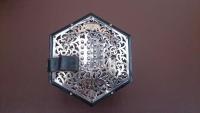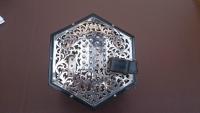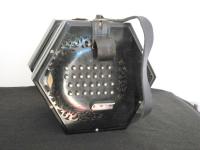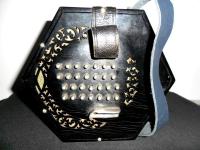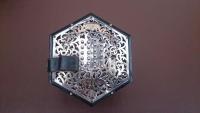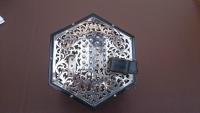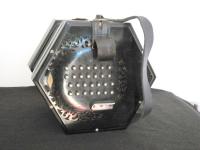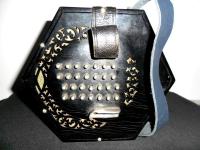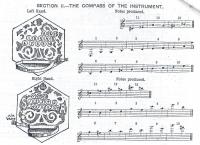
Dowright
Members-
Posts
270 -
Joined
-
Last visited
Everything posted by Dowright
-
Lachenal 31B Anglo - Date Of Manufacture?
Dowright replied to griffinga's topic in Concertina History
Thanks for pointing out my mistake. Here is the story: I originally got the information, more than a decade ago, from a concertina dealer who has been very reliable in providing information on a number of Lachenals. However, he mistakenly read the '3' as an '8' and gave me No. 187243. The footnote to my original entry shows all the information about THIS INSTRUMENT PLAYED TROUPS INTO BATTLE AT ARMENTIERES, Private A. Lewis, 71st Battalion, etc. (The bellows frame contains a listing of other battles: Seine, Aucre, Asine,Yesev, and Marne.) I quickly viewed the concertina.net posting in 2014 but, since no serial number was given, I did not recognize that it was the same concertina. I did not pay enough attention to the '"Pvt. A. Lewis" to see if it was in my database. A subsequent purchaser of the instrument then sent me the No. 137243, and I mistakenly entered it in my database without further consideration. I need to remove the No. 187243 and do considerable reworking of my assumptions for dating 20th century Anglo Lachenals. (My nemesis is late-period Anglos: I have an easier time in estimating for Englishes and Maccann and Crane duets and for earlier-period Anglos.) Here are a few thoughts: No. 137243 dates from about 1894. I have the receipt--which is shown somewhere here in concertina.net--for No. 140871 (32 key) dated Oct. 1895. So 20 years before Armentieres, Private Lewis would have bought the concertina or, more likely, he was the 2nd or 3rd owner. Here is a little info: No. 169404. Handwritten "T. Walpole, 58 Everton Brow, Liverpool , July 24, 1903." (20 key in Bb/F, wood fret, bone buttons, steel reeds 5-fold). No. 169101. Bill of sale by retailer Rushworth and Draper, February 27, 1906. (30 key in C/G, wood fret, bone buttons, steel reeds, 6-fold). Note the chronology of 2-1/2-year later sale of a lower number, which is consistent with what Stephen has said concerning that Lachenals probably were not always completed in the order of the serial numbers and (2) Rushworth and Draper may have had the concertina in inventory for some time. Using 28,000 instruments (197000 minus169000) over a 22-1/2 year period (mid-1903 to end-1925), gives an estimate of annual productiion of 1244, or about 1200-1250 per year. Hopefully, better and more complete estimates to follow in the future. DOWRIGHT, GET IT DONE! -
Lachenal 31B Anglo - Date Of Manufacture?
Dowright replied to griffinga's topic in Concertina History
Consider thew following by Edward Francis Rimbault in the "Musical Instruments" section of G. Phillips (ed.), British Manufacturing Industries, Vol. 11 (London; Edward Stanton, 1st ed. 1876; 2nd ed. 1878). "Another result of the use of the free-reed is the invention of the English concertina."(page 139). . . . . Another instrument has sprung out of this--the Anglo-German concertina . . . . It is of great commercial importance to Saxony and Vienna, where 400,000 are manufactured annually. In England, there are only two great makers, Messrs. Lachenal and Chidley (late Wheatstone), and the manufacture is about 5000 annually [bold added]." (page 140) This is the only citiation that I have for annual production of Anglo concertinas in the period. Note that if "5000 annually" is attributed to Lachenal, it is pretty close to my 1870s estimate--made independently--(see the above posting). [Rimbault must have been referring to Edward Chidley, because Rock Chidley had gone bankrupt more than a decade earlier. And Edward did not make many concertinas under his own name. I guess Rimbualt did not know about the George Jones and Jeffries operations.] Rimbault should be viewed as a pretty reliable source. He was an organist, musicologist, and musical antiquarian. He was best known as for the organ--player and author: The Organ: Its History and Construction (1855) and Early English Organ Builders and Their Works (1865). But he was also 'keyed-in" to the concertina. Under the pen name of "Franz Nava," he has over 100 popular music arrangements in the British Library. As Franz Nava, he published several collections of tunes specifically for concertina, as well as for violin, flute, cornet and clarionet: Chappell's 100 Irish Melodies ... or Concertina (1859), Chappell's 100 Scottish Melodies ... or Concertina (1859), Chappell's 100 Revival Hymns ... or Concertina (1874), etc. He was an associate and friend of Joseph Warren (prolific concertina music arranger and concertina tutor author) until they had a split. 400,000 annual production on the Continent! Even if somewhat overstated, it indicates impressive output. -
Lachenal 31B Anglo - Date Of Manufacture?
Dowright replied to griffinga's topic in Concertina History
I know that it seems far-fetched, but I have been researching a Lachenal article for more than a decade. It will stand on the shoulders of the two fine articles (Free Reed Journal and Papers of the International Concertina Association) by Stephen Chambers. Hopefully this posting will spur me into action to get the article drafted, sent to Stephen for comments, and finally released. One of the focal points of the article will be estimating the years of manufacture for Lachenals--Anglos, Englishes, Maccann duets, and Crane duets, of course. Two pitfalls of estimation are: 1. Confusing repair/retuning dates, inscribed inside Lachenals, with original sales dates. 2. Confusing invoice dates for second-hand Lachenals with invoice dates for newly manufactured Lachenals. Another point to consider is that Lachenal had an inventory of new concertinas for sale (unlike waiting for a couple off years today for your new Dipper, Carroll, Suttner, etc.). Picture walking into the little Lachenal showroom and, in the case below the picture of Dutch Day, are a number of new Lachenals that can be taken home TODAY). So year of manufacture may be a year or more before year of sale. The information on dates of repair/retuning is very important, not for estimating the year of manufacture, but for checking the estimates that have been made using other information. If the repair date precedes the estimated sale date, something is clearly wrong. So all repair dates most follow the estimated dates, but by how much? I have about 75 serial number/repair dates for Anglo concertinas. Casual observation suggests that a lot of the instruments were not repaired or even retuned until 8-10 years into their use. Here is a set of what I consider to be some good original-sale numbers: 1895 140871 1896 144430 1898 162849 1906 169404 1914 187243 1926 196856 Here are my first-cut estimates of annual production in various periods: 1862 300 (Notice that it appears that Louis Lachenal (RIP in December 1861) never made Anglos) 1863-1864 600 per year 1865-1873 2,578/yr 1874-1877 5,575/yr (Production more than doubled after "Louis Lachenal" became "Lachenal & Co.") 1878-1890 5,200/yr 1891-1898 6,500/yr 1899-1914 1,600/yr 1915-1927 850/yr 1928 500 1929 400 1930 300 1931 100 1932-33 Very few Notice that, by my estimates, sales went down by almost 50 percent during WWI and never recovered. I am posting the above material rather reluctantly, since I want to emphasize that these estimates are EXTREMELY TENTATIVE! -
Lachenal 31B Anglo - Date Of Manufacture?
Dowright replied to griffinga's topic in Concertina History
My best information is from handwriting inside a small-bodied (5 1/2 inches acrros the ends) 30-key in Bb/F. The serial number is No. 187243. It says "Led the troops into Armentieres, 13 October - 2 November 1914". Of course, the owner could have purchased it well before marching off to the trenches in 1914. But from the other information that I have, I think that there is a good chance that the purchase was in 1913 or 1914. Thus, I would estimate the year of manufacture for No. 188334 as circa 1915. -
There are nice images and a description of a 55-key wood-fret Crane New Model ( No. 532) at craneconcertina.com.
-
I do not have any photos of an Anglo New Model. The only one that I ever held was owned by a lady who died a couple years ago. I did not take any photos at the time when I saw it. I do not know where the concertina is today. But I have attached images (2 each) of metal-fret and wood-fret New Model Englishes. There may or may not be images of New Model Maccann and Crane duets at the respective websites devoted to these instruments.
-
This posting is misplaced. It is repeated in the Concertina History section under Lachenal "New Model" I do not have any photos of an Anglo New Model. The only one that I ever held was owned by a lady who died a couple years ago. I did not take any photos at the time when I saw it. I do not know where the concertina is today. But I have attached images (2 each) of metal-fret and wood-fret New Model Englishes. There may or may not be images of New Model Maccann and Crane duets at the respective websites devoted to these instruments.
-
Chutzpah is, of course, Yiddish for "shameless audacity." I think that chutzpah most certainly applies to an item currently in the concertina listing on Ebay. A sheet of paper showing the key layout diagram for a concertina is sold along with each cheap Italian-made Anglo concertina. The Ebay seller has a buy-it-now for such a sheet of paper, priced at $9.99 plus $4 postage and handling. (About 6.5 British pound sterling plus P&H; even more postage and handling charge for a non-US buyer). What's more: The diagram is for a 20-key C/G concertina--not even a 30 key. The photo of the diagram in the Ebay advertisement can be saved and/or copied at no cost. The concertina sites on the internet have loads of better key diagrams. If the seller is successful, they might consider trying to sell the Brooklyn Bridge to the key layout buyer--$9.99 plus shipping and handling, of course. http://www.ebay.co.uk/itm/ACCORDION-CHARTS-20-KEY-CONCERTINA-DIAGRAM-/321887208092?hash=item4af1f9029c:g:su0AAOSwsB9V~YKg
-
Here is some information about Lachenal New Model Anglo concertinas. Lachenal & Co. did not make New Model Anglos until circa 1929. The New Model Anglos had 4-digit serial numbers that were in the same serial number series as Maccann and Crane duets. The serial numbers of the New Model Anglos are on the exterior (top left of raised fretwork) as well as inside. Presumably, they wanted the serial numbers on the exterior without having to resort to 6-digit numbers a la the general Anglo serial number sequence at the time. They had been making New Model Maccann duets (since the late 1880s) and New Model Crane duets (since about 1900). It appears that their logic was to classify New Model Anglos along with duets on the basis of the New Model style, rather than classifying on the basis of Anglo-versus-duet fingering. Of 2,920 Lachenal Anglos, I have seen only 4 New Model Anglos--No. 4674, No. 4679. No. 4681, and No. 4759--each with either 30 or 40 keys. Toward the end of their existence, Lachenal made at least one Anglo Edeophone (No. 4860). Wheatstone made a few "Edeophone", using Lachenal materials and/or templates, after the closure of the Lachenal firm (see concertina.com). For English-system Lachenal concertinas, the New Model concertina appears to have originated in the early 1880s, a little before the advent of the Edeophone.
-
To my knowledge, the Wes Williams dating chart (see preceding posting) is the best set of estimates currently in print. However, for dating some Lachenal concertinas, a little reworking on the estimate is needed. Look at the Wes Williams chart, and compare with the following considerations: 1. Assigning Lachenal serial numbers (as opposed to Wheatstone serial numbers) to English-system concertinas basically started in about 1858 and seems to have started with serial number 5000. 2. Assigning serial numbers to Lachenal Anglo concertinas seems to have started at No. 1 in about 1862. 3. The best evidence is that Lachenal & Co. ceased its operations in 1933--not 1936. 4. The highest numbered English Lachenal (except for No. 87733) that I have seen is No. 60498. 5. The highest numbered Anglo Lachenal that I have seen is No. 201258. I have been working on an article about Lachenal for a long time. My article will build upon the two fine Lachenal articles by Stephan Chambers (see the Stephan Chambers tab in concertina.com). My article will include additional information on dating the manufacture of Lachenal concertinas.
-
When I first saw this thread, my guess was that the serial number was 38227 and, in fact, it is. I have serial numbers and descriptions for 2187 English-system Lachenal concertinas. The highest serial number for 2186 of them is No. 60498. The exception is No. 87733 (48 Keys, Wood Ends, Bone Buttons, and 5-fold bellows). That number of 87733 has been absolutely positively confirmed. My guess is that it was a mistaken stamp for 37733. My estimate for the year of manufacture of No. 38227 is 1900.
-
Ken, You mentioned 26-key Jones concertinas that have the same appearance as the illustration in the tutor. I also have one, but it is in Bb/F and, of course, does not have the lyre [sheet-music-holder attachment]. As you mentioned, the main rows of the Anglo layout are in the keys of C major and G major. However, given the accidentals in the 3-button top row, the tutor states: "The Army Concertina is capable of playing in any key . . . ." To make the point, the tutor has scale exercises in the keys of C major, G major, D major, A major. B major, F# major, F, Ab, Bb, and Eb. It also has two-note exercises on thirds, sixths, and octaves. The tutor even has sections describing the concertina components and information on concertina maintenance and repair. The tunes in the Anglo section are subdivided into (1) Melodies only, (2) Melodies with Simple Harmonies, (3) Accompaniment to Singing, and (4) Music for Concertina Bands (separate parts for 1st and 2nd concertina). The English concertina section has Easy Tunes, and the Appendix has additional tunes arranged for 1st and 2nd concertina. As would be expected of the SA, the tunes are spiritual, and I think that these tunes are not found in hymnals. (But one or more may still be used by the SA.) The Anglo section has tunes in regular music notation with tablature numbers above and below the staff and a set of tunes in a separate style of tablature without the regular musical staff. I think that I have sufficiently describe the tutor. If someone wants a copy, send me a personal message and we will see what can be done. Maybe I could scan all of the individual pages.
-
My comments are in response to "Ab/Eb Concertinas ..." started by "lachenal74693" in the General Concertina Discussion section on 29 August 2015. I view my comments as more appropriate for the History section. The discussion turned to the Ab/Eb Anglo concertinas used by the Salvation Army (SA). Booth's Instructions for the Salvation Army Concertina (1888) was mentioned. Later (1912) the Salvation Army endorsed the Triumph (Crane) duet concertina. But in the interim, the SA published a unique little guide in circa 1905--The Salvation Army Anglo-German and English Concertina Tutor. Though only 8 1/2 x 5 1/2 inches and only 72 pages, it contained sections on (Part I) The Rudiments of Music (pages 6-18), (Part II) The Salvation Army Concertina [26-key Anglo, the SA standard at the time] (pp. 19-40), (Part III) An Easy System [of Tablature] For the Concertina (pp. 41-51), (Part IV) The English Concertina (pp. 52-66), and (Appendix) Additional Tunes to Part IV (pp. 67-72). The only other tutor that I have discovered for both Anglo and English concertina is T. J. Juliana, New Instructions for the English & German Concertina (London: Joseph Williams, circa 1870.) I have more to say, but for now will just attach images of the cover, the 26-key SA Anglo concertina (by George Jones), and the note diagram.
-
In ancestry.com, the summary sheet for John Hill Maccann has his death as 1917 in West Ham, London, age 57. I could not find an underlying record for this entry, and I do not believe that it is correct. A couple years ago, I found the 1911 census record, as discussed above, and previously had found the 1908 marriage record, also discussed above. I also found a death record for a John McCann (or Maccann, I do not remember which) for after 1911 (I cannot remember what year) registered in Liverpool. No image was available, so I ordered the death certificate through Ancestry.com. I received a message saying that the death certificate ordered by me could not be provided. I continue to search for the documentation from the time when I ordered the death certificate. In my disappointment. I may have tossed whatever information that I had, but I do not think that I did. I will keep searching my files. I have managed to do a lot of concertina history research from here in the US. But occasionally, it would be so helpful to be located in the UK. I think that if I could visit the death records in Liverpool, I just might be able to obtain the relevant record. Maybe someone else can do so.
-
Small/miniature Concertinas?
Dowright replied to Roger Hare's topic in General Concertina Discussion
Roger, Please see my article--R. Merris, "Miniature and Semi-miniature Concertinas," Papers of the International Concertina Association, Vol. 9 (2012), pp. 8-39. In addition to the text, there are lots of images of miniatures, semi-miniatures, key layouts, and some of the many concertina professionals who played them. (I wish the images were in color, which really would show off their style.) The article is archived at the International Concertina Association website--www.concertina.org. Click on the PICA tab on the left of the home page. Click on PICA Vol. 9. Click on Download PICA09-2012 (18MB) I think the article will contain just about all you want to know about miniature concertinas and semi-miniature concertinas. (Maybe even more than you want to know!) -
Maybe some of Roger's confusion can be eliminated. There are major problems with the information in the articles that he found at concertina.net for the dating of Lachenal concertina manufacture. The so-called "confirmed dates" (serial number-year combinations) in the articles are far from accurate. My guess is that the authors thought that these dates pertained to original purchase when, in fact, they were repair/retuning dates. Their date for the beginning of Anglo manufacture at Lachenal is 1850, whereas such manufacture actually started in about 1862. (Given that Louis Lachenal died in late 1861, he may never have sold an Anglo Lachenal.) Their next date is 1860 for No. 11653. Again, the date precedes the advent of Lachenal Anglos. (I estimate 1868 for No. 11653.) Then they have 1868 for No. 18197. (I tentatively estimate 1871 for No. 18197). Next they have 1895 for No. 51480. (I estimate 1878 for No. 51480, where the estimate is reinforced by a sales receipt of 1 January 1878 for No. 46951.) Their last number is 140375 dated as 1908. (I estimate that No. 140375 was made in 1895. I have a sales receipt for No. 140871 dated October 1895.) Dating your No. 106253 as made in 1889: I have a sales receipt for April 1888 for No. 104739, and a sales receipt for 1890 for No. 109790. Dating your No. 74693: I estimate that it was made in about 1883. All this points to the fact that most dates found in handwriting inside concertinas are repair/retune dates. Caution must be exercised even with the dates on sales receipts, given that a receipt could pertain the to sale of a used, rather then new, Lachenal concertina. (Incidentally, one of the articles on dating the instruments gives 1936 as the "known finishing date" for Lachenal & Co. In fact, the company went out of business in 1933.)
-
Lachenal No. 106253 was made around 1889--not in the first decade of the 20th century.
-
Early Wheatstone Treble English At Upcoming Auction
Dowright replied to Chris Drinkwater's topic in Buy & Sell
And the serial number for their No. 77 must be wrong. It is most likely 3470, but certainly is not 8470. Lachenal did not build duets tin the 8000 range. -
Lachenal 20B Anglo #182489 With 1/1/16 Inscription
Dowright replied to nkgibbs's topic in Concertina History
The dating is way, way off base. I have enough evidence to confidently state that the concertina was made in about 1909. Caution: Misinterpreting just one handwritten inscription as an original purchase date--rather than what is really a repair/retune date, can lead to really bad estimates of the date of manufacture. Such misinterpretation appears in one or more of the sources posted at concertina.net, which you have cited. -
Not much can be said for sure, other than it was made in about 1887. Reeds? most Anglos from this period had steel reeds but there were exceptions. Five or six fold bellows?. Each type was used for Anglos of this period. I am guessing that this one has 5-fold bellows (given the relatively cheap light-wood ends). Those uninitiated about Lachenal serial numbers might think the the exclamation point in your posting is a "1", leading them to an impossible serial number, higher than 900,000.
-
Chris Drinkwater mentioned me (Dowright = Merris) in suggesting circa 1922 for the manufacture of your Lachenal concertina. I thought you would appreciate a little more information. A Lachenal sales receipt for 10 July 1923 shows that Mr. E. Perkins purchased No. 58885, a 56-key Edeophone. Another sales reciept for 10 July 1923 shows that his brother, Mr. A. E. Perkins, purchased No. 58887, a 48-key Edeophone with raised wood ends, metal buttons, steel reeds, 6-fold bellows, and bowing valves. However, the sales receipt for a 56-key Edeophone with a higher serial number--No. 59086--was sold on 2 April 1923. more than 3 months before the puchases by the Perkins brothers. This points to the fact that Lachenal carried an inventory (as did Wheatstone et al). A buyer could walk into the small Lachenal showroom and below the large photo of Dutch Daly (music-hall comedian and concertinist) was a display of new Lachenal concertinas that could be purchased and taken home the same day. Some of the concertinas may have been in the display case for months. This contrasts with today, when there is a long wait for completion of a custom instrument, and the manufacture date is almost always very close to the sales date. Thus, I concur with Chris's dating of c.1922.
-
Johansson1991, For more information see my article: "Miniature and Semi-miniature Concertinas," Papers of the International Concertina Association, Vol. 9 (2012), pp. 8-39. The article was recently posted at the website of the International Concertina Association (www.concertina.org). Click on the PICA tab on the left side of the home page and go to PICA Vol. 9 - 2012. Wheatstone did make a few miniature duet concertinas but, as pointed out in earlier responses to your post, your semi-miniature has an English system layout. By having few keys, it is a far-cry easier to learn to play than a full-size 48-key English concertina. So "Go For It" whether or not you get into playing a full-size instrument.
-
It's fair to say that the International Concertina Association (ICA) got to Matthew Talty before the New York Times and with more information about him. See my article co-authored with his son (also Matthew): "The Old Man with the Cap: Matthew Talty and His Concertina," Concertina World (Magazine of the ICA), No. 455 (2013), pp. 2-7.
-
I am interested in bidding on your concertina, but I would need the serial number and knowing if it has brass or steel reeds. Other potential bidders my feel the same.

